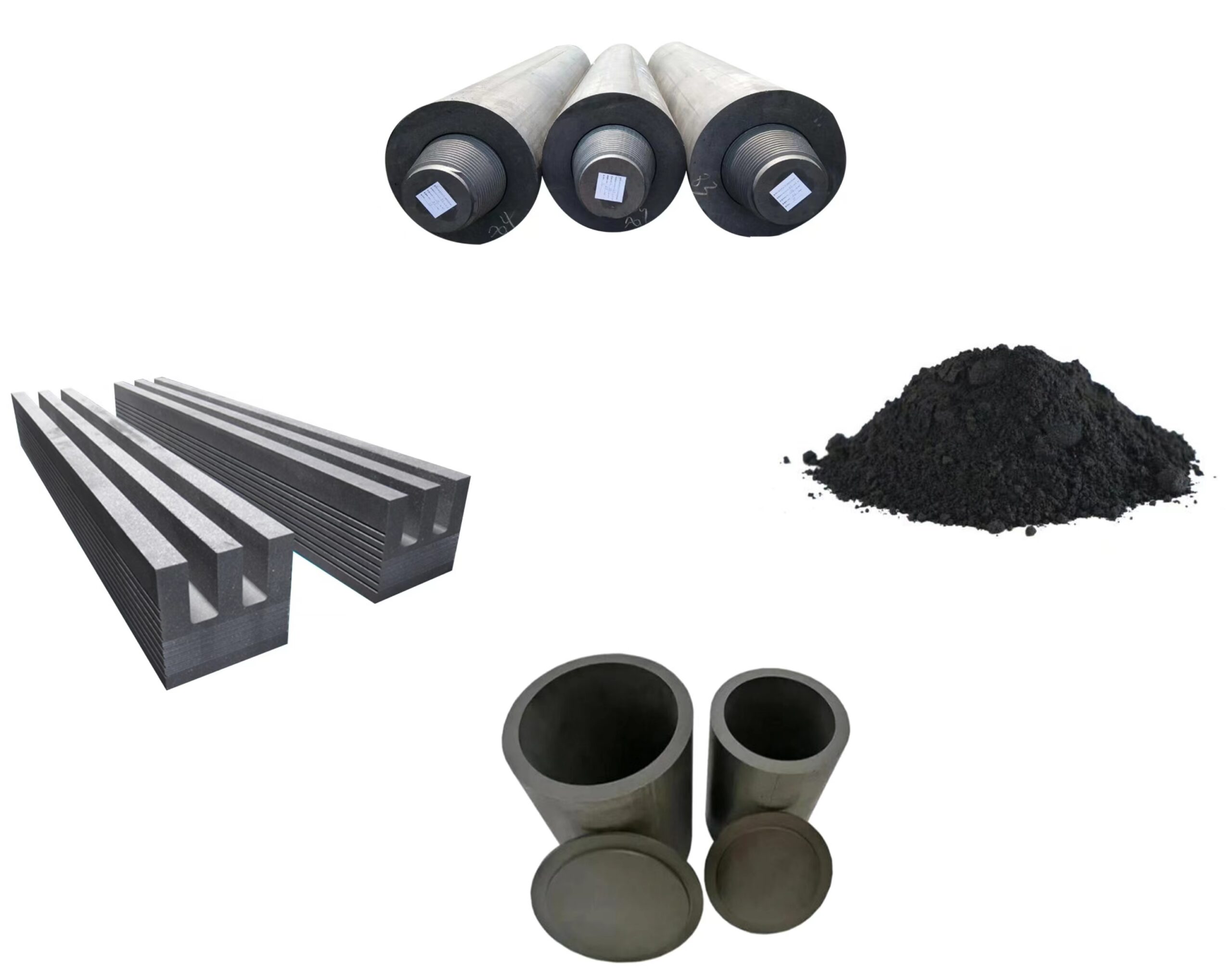Endüstri geliştikçe grafit önemli bir rol oynamakta ve grafit için yeni kullanım alanları ortaya çıkmaya devam etmektedir. Grafit bir karbon allotropudur, yani belirli bir şekilde düzenlenmiş ve bağlanmış karbon atomlarından oluşan bir maddedir. Şimdi grafitin bazı uygulamalarına daha yakından bakalım.
İçindekiler
GeçişGrafitin endüstrideki kullanım alanları
Yarı iletken endüstrisi
Yarı iletkenlerde kullanılan grafit malzeme yüksek saflıkta, ince parçacıklara ve yüksek sıcaklık direncine sahiptir. Tek kristal silikon ve polikristal silikon üretimi gibi.
Havacılık ve askeri sanayi
Diğer malzemelerle karşılaştırıldığında grafit korozyona dayanıklı ve hafiftir ve roket nozulları ve uçak fren balataları olarak kullanılabilir.
Ark ocakları için grafit elektrotlar
Bir elektrik iletkeni olarak, grafit elektrot yüksek elektrik iletkenliğine sahiptir ve elektrik ark fırınlarındaki kimyasal reaksiyona katılmaz. Çalıştırıldığında, çeliği eritmek için büyük miktarda ısı üretir.
Alüminyum elektrolizi
Elektrolitik hücreler için iletken bir kendiliğinden pişen anot olarak, alüminyum eritme için kullanılır. Önceden pişirilmiş anotlar ve karbon macunu elektrotları olarak ikiye ayrılır.
Demir dışı metal döküm
Grafit kalıplar iyi işleme özelliklerine sahiptir ve dökme demir, bakır ve alaşımlar için kullanılır.
Mekanik endüstrisi
Rulman, piston ve sızdırmazlık malzemesi olarak kullanılır, iyi aşınma direnci ve sızdırmazlık özelliklerine sahiptir.
Nükleer reaktörler
Bir yavaşlatma malzemesi ve yansıtıcı malzeme olarak grafitin yüksek saflığı ve yoğunluğu nükleer reaksiyonlar için uygundur.
EDM işleme
Grafit, diğer malzemelere göre daha ucuz ve daha az kayba sahip olan elektrospark işleme için bir elektrot malzemesi olarak kullanılır.
Elektrik endüstrisi
Grafitin direnci metallerinkinden çok daha düşüktür ve direnç olarak kullanılır.
Kuru Yağlayıcılar
Doğal grafit veya sentetik grafit toz grafit çok iyi yağlama özelliklerine sahiptir ve yaygın olarak yağlayıcı.
Refrakter malzemeler
Grafit yüksek termal stabiliteye sahiptir, bu nedenle yüksek fırınlar ve boru hatları gibi yüksek sıcaklıklı ortamlarda kullanılır. Refrakter tuğlalar, sürekli döküm tozu, döküm kalıpları vb. Çelik üretim fırınları için astar malzemesi olarak kullanılabilirler ve ayrıca çeliğin sürekli dökümünde de kullanılabilirler.
Nadir toprak eritme
Esas olarak grafit anotlar, grafit potalar (kil ve grafit pota dahil) ve eritme için kullanılan iletken elektrotlar. Grafit anot, nadir toprak eritme, nadir toprak metal oksitlerinin elektrolizi ve metal saflaştırmada kullanılır. Anot, nadir toprak eritme endüstrisinde elektroliz işleminde kullanılan, anot olarak var olan ve kimyasal reaksiyonlara katılan bir sarf malzemesidir.
Karbon Fırçaların İçindeki Grafit
Grafit, elektrik motorlarında, jeneratörlerde ve alternatörlerde elektrik akımını çalıştırmak için kullanılan karbon fırçaların temel bir bileşenidir. Motorlarda ve jeneratörlerde akımı almak için iletken olarak kullanılır.
Fotovoltaik ve LED
Grafit, fotovoltaik endüstrisinde yaygın olarak kullanılmaktadır. güneş enerjisi üretimi. Örneğin, grafit potalar polikristalin silikon ve monokristalin silikon üretiminde kullanılmaktadır.
Enerji sektörü
Grafen levhalar lityum-iyon pillerin ve süper kapasitörlerin performansını artırabilir ve yakıt hücrelerinde de kullanılabilir. Alternatif enerji kaynaklarına olan talep artmaya devam ettikçe, güneş panelleri ve rüzgar türbinlerinde giderek daha popüler hale gelmektedir.
Spektral analiz
Grafit ürünler ölçüm ve ölçüm için kullanılan yüksek analitik hassasiyete sahiptir ve aynı zamanda iyi elektrik ve ısı iletkenleridir.
Pil Teknolojilerinde
Grafit, lityum-iyon pillerin dışında katı hal ve akış pilleri gibi gelişmekte olan teknolojilerde giderek daha önemli hale gelmektedir. Enerji depolama iyileştirmeleri için temel olan, şarj-deşarj verimliliği ve kapasitesidir.
Dökümhane ve döküm
Sürekli döküm kalıpları için bir malzeme olarak grafit, deformasyon veya çatlama olmaksızın büyük sıcaklık farklılıklarına dayanabilir. Çünkü düşük bir termal genleşme katsayısına sahiptir.
Toz Metalurjisinde Grafity
Sinterleme işlemi, metal parçacıklar ve kalıplar arasındaki sürtünmeyi azaltmak için yağlayıcı olarak Grafit kullanır ve metal ürünlerin mükemmel bir şekle ve etkinliğe sahip olmasını sağlar.
Isı Değişim Sistemlerinde Grafit
Mükemmel termal iletkenlik ve korozyon direnci, grafiti kimyasal işleme ve yüksek sıcaklık gerektiren diğer endüstrilerdeki ısı eşanjörleri için en iyi seçim haline getirmektedir.
Aktüatörler ve Sensörler alanında
Endüstriyel ve çevresel izleme sensörleri grafitin iletkenliğinden ve elektriksel hassasiyetinden faydalanır. Akıllı sensörler ve aktüatörler, grafitin nem, sıcaklık ve basınç değişikliklerini algılama özelliğinden yararlanır.
Tıbbi
Yapay iç organlarda, yapay eklemlerde, diş köklerinde ve kan damarlarında grafit malzemelerin araştırılması ve uygulanması. Düşük ağırlığı ve sağlam karakteri, mukavemet ve biyouyumluluk gerektiren tıbbi gelişmeler için mükemmel olmasını sağlar.
Membran Teknolojisi
Gelişmiş filtrasyon sistemleri, özellikle tuzdan arındırma tesislerinde ve gaz ayırma ünitelerinde membranlarda grafit malzemeler kullanarak sıvıları veya gazları ayırır. Kimyasal direnci ve yapısal kararlılığı filtrasyon verimliliğini artırır.
Kaplamalar ve Korozyon Önleyici Boyalar
Grafit, özellikle denizcilik ve endüstriyel altyapı için korozyon önleyici boyalar ve kaplamalarda daha da kritik hale geliyor. Zorlu ortamlara karşı direnci köprülerin, gemilerin ve boru hatlarının daha uzun süre dayanmasını sağlar.
Karbon Nanotüpler
Grafit, yüksek mukavemeti ve elektrik iletkenliği nedeniyle, elektronikten tıbbi ekipmana kadar her şeyde bulunabilen karbon nanotüplerin yapımında kullanılan öncü bir malzemedir.
Spor ekipmanları
Grafit tenis raketleri hafif ve esnektir, spor konforunu ve güvenliğini artırır.
Kırtasiye Malzemeleri
Kurşun kalem uçları, mürekkepler, fotokopi tonerleri vb. grafitin yüksek eğilme mukavemetinden yararlanır.
Sonuç
Yeni teknolojilerin ve yeni malzemelerin sürekli olarak ortaya çıkması nedeniyle grafitin kullanım alanları artmaktadır. Sadece endüstride değil, günlük hayatta da yaygın olarak kullanılmaktadır.

